Doha Forum: Azerbaijan and Armenia discuss regional peace
At the Doha Forum, Assistant of the President of the Republic of Azerbaijan Hikmat Hajiyev and Secretary of the Armenian Security Council Armen Grigor...
The world's largest inland body of water is experiencing an unprecedented environmental catastrophe that threatens to reshape the geopolitical and ecological landscape of Central Asia.
The Caspian Sea has reached its lowest recorded level at 29.2 metres below sea level in 2024, marking a dramatic 2.3-metre decline since 1996 and representing the most severe water crisis in the sea's documented history. This alarming trend, driven primarily by reduced inflows from the Volga River and accelerated by climate change, poses existential threats to biodiversity, regional economies, and the livelihoods of over 15 million people living along the Caspian coastline.
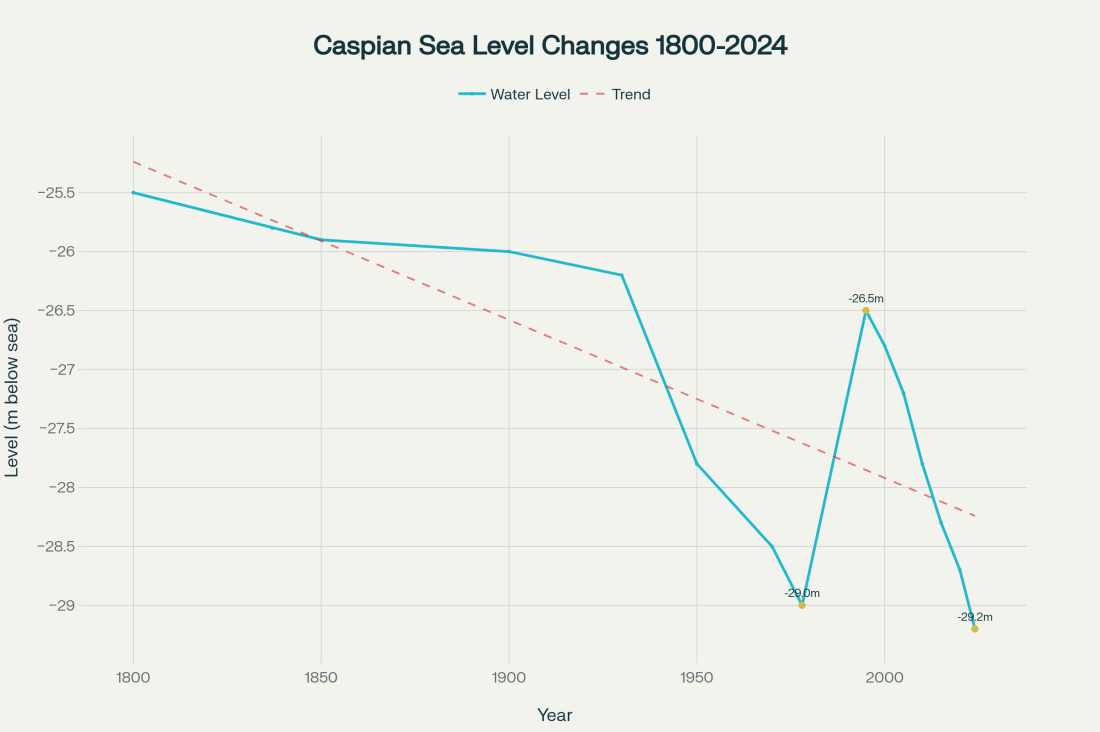
Understanding the Scale of the Crisis
Historical Context and Current Alarming Trends
The Caspian Sea's water levels have fluctuated naturally throughout history, but the current decline represents an unprecedented acceleration of environmental degradation. Systematic monitoring began in 1837, providing nearly two centuries of data that reveals the severity of the present crisis. From 1978 to 1995, the sea experienced a recovery period, with water levels rising by 2.5 metres, leading to coastal flooding in some areas. However, since 1996, the decline has been relentless and accelerating.
Recent satellite data from NASA demonstrates that the sea level has decreased by approximately 2 metres between 1992 and 2024, with the rate of decline increasing dramatically since 2020. The current level of -29.2 metres below sea level represents not merely a statistical anomaly but a fundamental shift in the sea's hydrological balance that threatens to trigger cascading environmental and economic consequences across the entire region.
The magnitude of this crisis becomes even more apparent when considering the sea's vast scale. The Caspian Sea covers approximately 371,000 square kilometres, making it larger than the entire United Kingdom. The northern section, which is particularly shallow with depths averaging only five metres, has already lost significant surface area, with new islands emerging as water levels retreat.
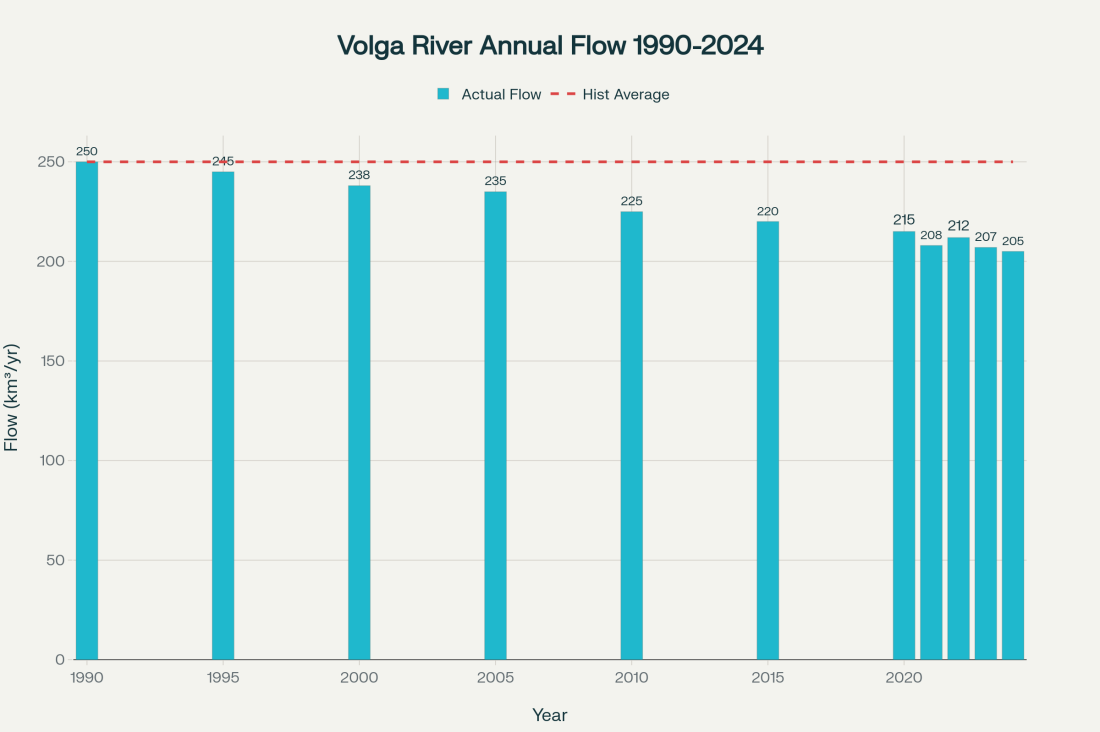
The Volga River Factor: Primary Driver of Decline
The Volga River, Europe's longest waterway at 3,530 kilometres, serves as the primary lifeline for the Caspian Sea, contributing approximately 80% of the sea's total water inflow.
Under normal conditions, the Volga discharges about 250 cubic kilometres of water annually into the Caspian, maintaining the delicate hydrological balance that has sustained the ecosystem for millennia.
However, this critical water supply has diminished catastrophically in recent decades. Current annual discharge has fallen to just 205-207 cubic kilometres, representing an 18% reduction from historical averages.
This decline stems from multiple factors, including the construction of over 40 dams along the Volga's course, increased agricultural irrigation demands, and reduced precipitation in the river's drainage basin due to climate change.
The ramifications of this reduced inflow extend far beyond simple mathematics. The Volga River basin drains 1.36 million square kilometres of territory, hosting nearly 40% of Russia's population and supporting vast agricultural and industrial activities.
As water demands in this region continue to increase, particularly following Western sanctions that have intensified Russia's focus on domestic agricultural production, the competition for Volga water resources has become increasingly acute.
Environmental Catastrophe and Biodiversity Loss
Ecosystem Collapse Across Multiple Species
The Caspian Sea's environmental crisis represents one of the most severe biodiversity disasters unfolding globally. The sea historically supported over 300 species of endemic invertebrates and 76 endemic fish species, creating a unique ecosystem that evolved in isolation from the world's oceans. This biological treasure trove now faces systematic destruction as water levels plummet.
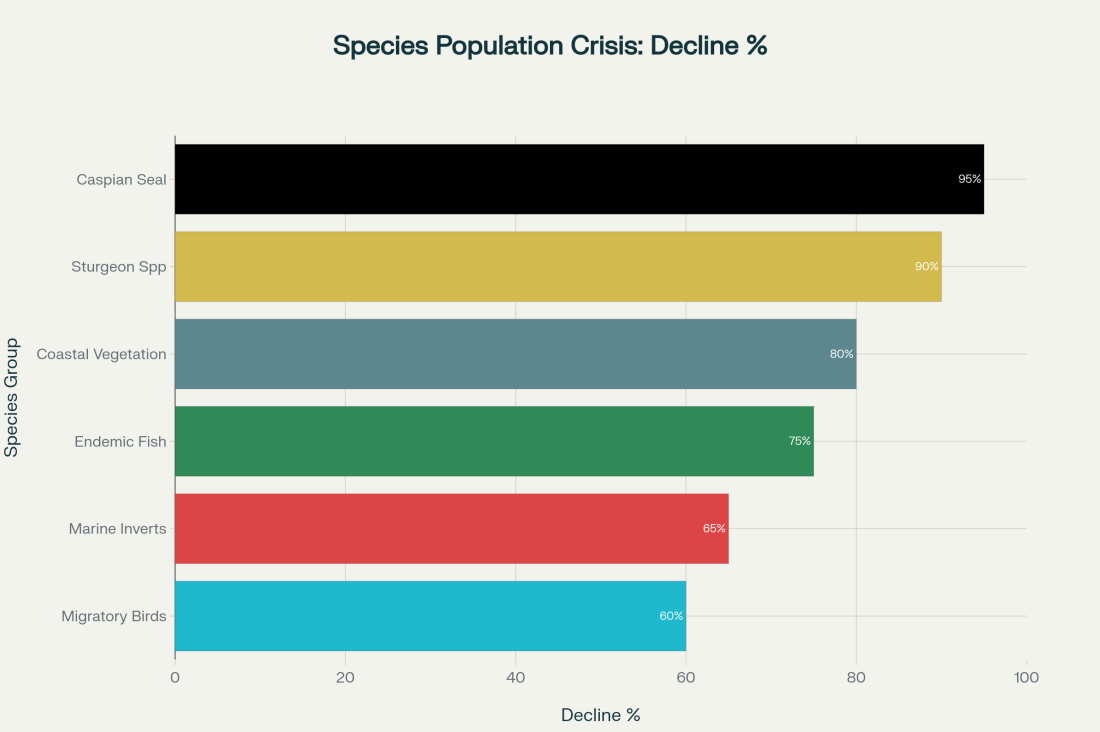
The Caspian seal, the sea's most iconic species, exemplifies the catastrophic impact on wildlife. Listed as endangered by the International Union for the Conservation of Nature since 2008, the Caspian seal population has already declined by over 95% in the past century, with fewer than 70,000 individuals remaining. These seals depend entirely on winter sea ice in the northern Caspian for breeding, but declining water levels threaten to eliminate 57% of their breeding habitat with just a 5-metre drop in sea level, and 81% with a 10-metre decline.
Sturgeon species, the source of the world's most prized caviar, face an equally dire fate; already reduced by 90% over the past 50 years due to overfishing and habitat destruction, sturgeon populations could lose an additional 25-45% of their shallow-water habitat as the sea continues to shrink.
These ancient fish require specific depths and conditions for spawning, and the retreating waters are eliminating their traditional breeding grounds in river deltas and coastal shallows.
The collapse extends beyond charismatic megafauna to the fundamental building blocks of the ecosystem. Endemic fish species face habitat reductions of 65-75%, while marine invertebrates that form the base of the food web are experiencing population declines of 65%. Coastal vegetation, critical for preventing erosion and providing wildlife habitat, has declined by 80%, with projections indicating near-complete loss in many areas if current trends continue.
Protected Areas Under Threat
The systematic destruction of biodiversity becomes even more alarming when considering the fate of protected areas.
Currently, 16.8% of the Caspian Sea enjoys some form of protection, but a 5-metre decline in water levels would reduce this to just 7%, while a 10-metre drop would leave merely 1% of protected areas intact. Four out of every ten unique ecosystem types in the Caspian would vanish entirely, representing an irreversible loss of global biodiversity.
Ecologically or Biologically Significant Marine Areas (EBSAs) and Important Marine Mammal Areas (IMMAs) face devastating losses.
More than half of some EBSAs would disappear completely with moderate sea level drops, whilst three northern ecoregions would lose over 80% of their coverage.
This represents not just local environmental damage but a global conservation catastrophe affecting species found nowhere else on Earth.
Economic Devastation Across Five Nations
Port Infrastructure and Maritime Trade
The economic implications of the Caspian Sea's decline extend far beyond environmental concerns, threatening the foundation of regional prosperity and international trade connections.
The sea serves as a crucial link in the Trans-Caspian International Transport Route, known as the Middle Corridor, which has gained strategic importance since 2022 as an alternative to Russian transit routes connecting China, Central Asia, the Caucasus, and Europe.
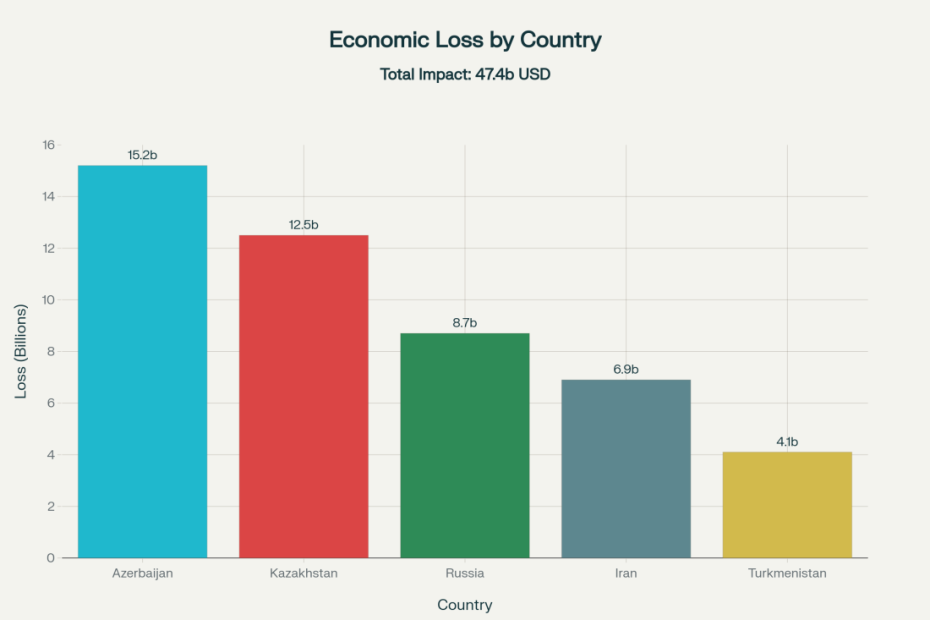
Azerbaijan faces the most severe economic impact, with estimated losses of £15.2 billion as ports struggle to maintain operations.
The Dubendi oil terminal, Azerbaijan's largest Caspian facility, has already seen oil shipments decline from 880,000 tonnes to 810,000 tonnes in the first half of 2025 due to reduced water levels.
Maintaining navigable depths now requires continuous and expensive dredging operations, with over 250,000 cubic metres of dredging completed at Dubendi in 2024 alone.
Kazakhstan, with the longest Caspian coastline at 1,894 kilometres, confronts economic losses of £12.5 billion as its vital ports of Aktau, Kuryk, and Atyrau face operational difficulties.
The Kashagan oil field, one of the world's largest offshore developments, requires increasingly expensive modifications to maintain access as waters recede.
Ships now carry reduced cargo loads due to decreased water depths, whilst some vessels struggle to reach port facilities designated for deeper waters.
Russia's economic exposure includes £8.7 billion in losses, particularly affecting the crucial port of Astrakhan, where ships increasingly cannot dock due to shallow waters.
The Volga-Don Canal, connecting the Caspian to the global shipping network, faces operational challenges that could sever this vital trade artery.
Iran and Turkmenistan collectively face over £11 billion in combined losses as their fishing industries, energy exports, and coastal infrastructure adapt to the changing coastline.
Energy Sector Disruption
The energy sector, which forms the backbone of the Caspian regional economy, faces unprecedented challenges as water levels decline.
The region contains proven oil reserves of 37.6 billion barrels and natural gas reserves of 18.9 trillion cubic metres across Kazakhstan, Azerbaijan, and Turkmenistan.
However, accessing these resources becomes increasingly difficult and expensive as offshore platforms require extended pipelines and deeper channels to reach production facilities.
Kazakhstan's oil production, which reached 90 million tonnes in 2023, depends heavily on Caspian transport infrastructure, with up to 80% of export-oriented oil traditionally transported through maritime routes.
The BTC (Baku-Tbilisi-Ceyhan) pipeline system, carrying 1.2 million barrels per day, relies on stable port operations that are increasingly compromised by falling water levels.
The Climate Change Accelerator
Rising Temperatures and Increased Evaporation
Climate change serves as both a direct driver and an accelerating factor in the Caspian Sea's decline. Average annual surface air temperatures over the sea have increased by approximately one degree Celsius between 1979 and 2015.
This temperature rise, combined with changing wind patterns, has significantly increased evaporation rates across the sea's 371,000 square kilometre surface.
The relationship between temperature and evaporation creates a devastating feedback loop. As global temperatures rise, evaporation accelerates exponentially, whilst precipitation patterns shift to provide less replenishment.
The Caspian region has experienced some of the lowest precipitation levels in decades from 2006 to 2022, creating perfect conditions for accelerated water loss.
Current projections based on climate models from the inter governmental Panel on Climate Change indicate that if global warming continues unabated, the Caspian Sea level could drop by 9-18 metres by the century's end.
Under the most severe scenarios, the sea could lose up to 34% of its surface area, with the northern section potentially disappearing entirely.
Precipitation Patterns and Regional Climate Impact
The Caspian Sea's decline creates regional climate effects that extend far beyond its shores. The sea serves as a crucial climate regulator for Central Asia, moderating temperatures and influencing precipitation patterns across vast territories.
As the sea shrinks, these regulatory effects diminish, potentially triggering further desertification and climate instability in surrounding regions.
Reduced precipitation in the Volga River basin, which has experienced several exceptionally dry years, compounds the crisis by limiting natural water replenishment.
The river basin's precipitation varies from 75 to 1,200 millimetres annually depending on location, but recent years have consistently fallen below historical averages, creating a self-reinforcing cycle of decline.
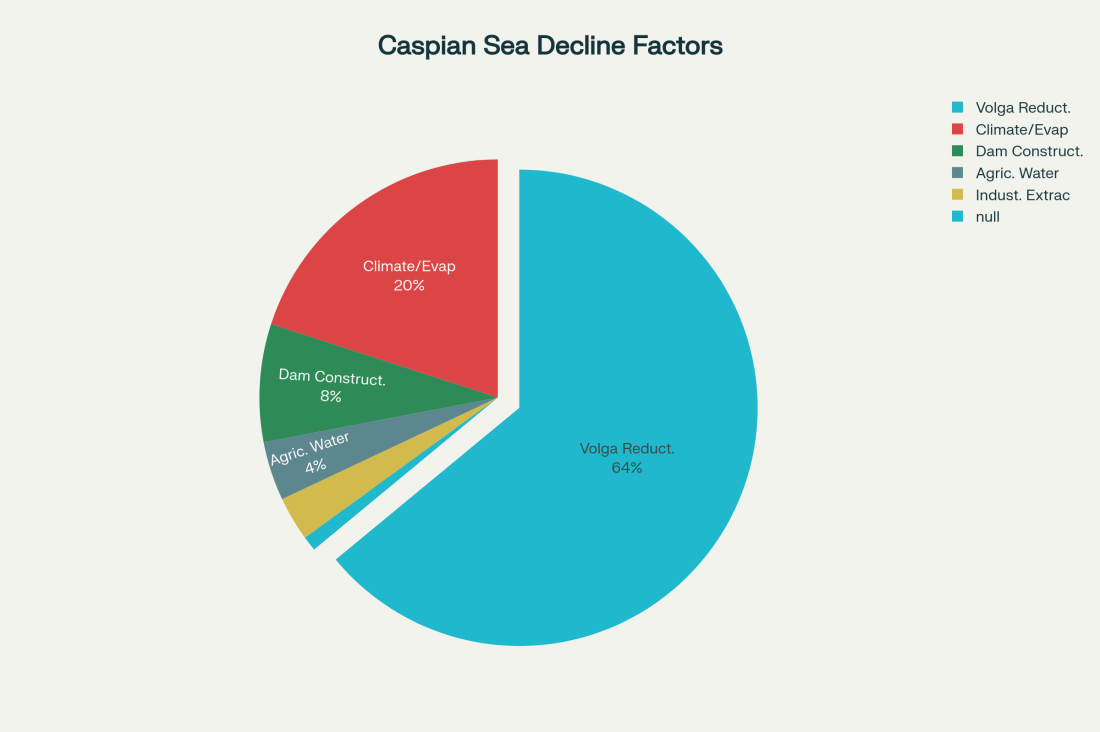
Root Causes and Contributing Factors
Dam Construction and Water Management
The construction of extensive dam systems along the Volga River represents a significant anthropogenic factor in the Caspian's decline, though experts debate its relative importance compared to climate factors.
Russia has constructed over 40 major dams along the Volga, with 18 additional projects under study or construction.
These facilities, whilst providing hydroelectric power and flood control, fundamentally alter the river's natural flow patterns and reduce downstream water delivery.
However, the relationship between dams and sea level decline proves more complex than simple water retention.
Dr. Amir Aliyev, a leading Azerbaijani geographical scientist, argues that hydraulic structures have existed during both periods of Caspian decline and recovery, suggesting that dam construction alone cannot explain the current crisis.
Instead, the combination of dam operations with reduced precipitation and increased water demands creates a compounding effect that exacerbates natural climate variations.
Agricultural expansion in the Volga basin, intensified by geopolitical factors including Western sanctions and food security concerns, has increased irrigation demands substantially.
This agricultural intensification, whilst economically necessary for Russia, further reduces water available for downstream flow to the Caspian Sea.
Industrial Water Extraction and Pollution
Industrial activities throughout the Caspian basin contribute both to water extraction and environmental degradation.
The magnitude of fossil fuel extraction and transport activity poses ongoing risks to the marine environment, whilst simultaneously requiring substantial water resources for operations.
Oil and gas facilities, chemical plants, and other industrial installations extract water for cooling, processing, and other operations, reducing overall inflows to the sea.
Pollution from industrial sources, agricultural runoff, and urban areas creates additional stress on the ecosystem.
The UN Environment Programme has identified the Caspian as suffering "an enormous burden of pollution from oil extraction and refining, offshore oil fields, radioactive wastes from nuclear power plants and huge volumes of untreated sewage and industrial waste introduced mainly by the Volga River".
This pollution load compounds the effects of water loss by degrading habitat quality and disrupting food webs.
International Cooperation Challenges
The Tehran Convention Framework
Efforts to address the Caspian crisis have been hampered by complex geopolitical relationships and competing national interests among the five littoral states.
The Convention for the Protection of the Marine Environment of the Caspian Sea, signed in 2003 and effective since 2006, provides a framework for environmental cooperation, but implementation remains incomplete.
The convention includes four protocols addressing oil pollution, land-based pollution sources, biodiversity conservation, and environmental impact assessment. However, only the first two protocols have entered into force, whilst Russia and Iran have yet to ratify the remaining agreements. This reluctance appears driven by economic and strategic interests that prioritise resource exploitation over environmental protection.
Water Rights and Transboundary Management
The absence of effective transboundary water management represents perhaps the greatest institutional failure in addressing the Caspian crisis. Despite the Volga River providing 80% of the sea's inflow, no binding agreements exist to guarantee minimum flow levels or coordinate water use across the river basin.
Kazakhstan has proposed demanding guarantees from Russia for minimum Volga River flow, but Russia maintains that the river is not a transboundary watercourse and therefore accepts no international obligations regarding its management.
This position effectively allows unilateral Russian decision-making over water resources that directly impact the environmental and economic security of four other nations.
Iran's Vice President Ali Salajegheh has publicly criticised neighbouring countries, particularly Russia, for blocking water inflows to the Caspian Sea, calling for resolution through the Tehran Convention framework.
However, the lack of enforcement mechanisms and conflicting national interests have prevented meaningful progress towards coordinated water management.
Potential Solutions and Mitigation Strategies
Integrated Water Resource Management
Addressing the Caspian Sea crisis requires comprehensive implementation of Integrated Water Resource Management (IWRM) strategies across all affected nations.
This approach must begin with developing action plans that address the reducing sea level through coordinated measures to minimise anthropogenic impacts on the water balance.
River inflow management represents the most critical intervention point, given that reduced Volga flow accounts for 64% of the sea level decline.
Russia must establish sustainable irrigation levels in inflowing rivers whilst monitoring both quantity and quality of discharged water. This includes optimising dam operations to maximise downstream flow during critical periods, potentially requiring modifications to existing hydroelectric and flood control operations.
Desalination management requires cooperation among riparian states to establish agreements on acceptable desalination rates that minimise impact on water levels.
Current desalination activities, whilst providing crucial freshwater for coastal populations, further reduce the sea's volume and must be balanced against environmental consequences.
Technological and Engineering Solutions
Advanced technological solutions could help mitigate some impacts of the crisis whilst buying time for broader systemic changes. Improved water conservation technologies in agriculture could significantly reduce irrigation demands in the Volga basin, freeing additional water for downstream flow. Precision agriculture, drought-resistant crops, and advanced irrigation systems could maintain agricultural productivity whilst reducing water consumption.
Enhanced dredging capabilities and adaptive port infrastructure can help maintain maritime operations despite declining water levels. Azerbaijan's recent completion of the Engineer San Kazimov dredging vessel, capable of deepening seabeds to 18 metres, demonstrates how technological solutions can preserve critical infrastructure functionality.
Ecosystem restoration programmes could help preserve biodiversity whilst adapting to changing conditions. Dynamic conservation approaches that adjust protected area boundaries as conditions change could maintain habitat connectivity and species protection more effectively than static protected zones.
Regional Cooperation Mechanisms
Effective solutions require unprecedented levels of regional cooperation that transcend current geopolitical tensions.
The Save the Caspian Sea campaign, founded by environmental lawyer Vadim Ni, advocates for international cooperation, corporate accountability, and transparency in addressing the crisis.
This grassroots movement has organised roundtables bringing together scientists, activists, media representatives, and government officials to build consensus for action.
Reactivating and strengthening the Tehran Convention represents the most viable pathway for formal cooperation.
This requires political will from all five littoral states to prioritise environmental security over short-term economic interests. Enhanced monitoring programmes, joint research initiatives, and coordinated policy responses could provide the foundation for effective crisis management.
Future Projections and Scenarios
Scientific Predictions for Sea Level Decline
Current scientific projections paint an increasingly dire picture of the Caspian Sea's future. Under medium to high emission scenarios, water levels could fall by 9-18 metres by the century's end, reducing the sea's total area by up to 34%.
The most severe projections suggest declines of up to 30 metres, which would fundamentally transform the region's geography.
The northern Caspian, already the shallowest section, faces complete desiccation under most scenarios. An area of 112,000 square kilometres—larger than Iceland—could emerge as dry land even under optimistic projections involving a 10-metre decline.
This transformation would create new desert landscapes whilst eliminating crucial habitat for countless species.
Timeline projections suggest that visible impacts will accelerate dramatically over the next 10-15 years. Russian meteorological officials predict continued decline throughout this period, with rising air temperatures, decreasing river flow, and consequently further lowering of sea levels.
The rate of decline has already increased from an average of 20 centimetres annually to over 25 centimetres in recent years.
Long-term Regional Implications
The long-term implications of continued Caspian decline extend far beyond environmental concerns to encompass fundamental questions of regional security, economic stability, and human habitability.
Geopolitical tensions could escalate as five nations compete for dwindling resources, potentially leading to new conflicts over water rights and shifting territorial boundaries as coastlines retreat.
Population displacement represents an inevitable consequence of continued decline. Millions of people whose livelihoods depend on fishing, maritime trade, and coastal industries may require relocation as their communities become economically unviable.
The experience of the Aral Sea's desiccation provides a sobering preview of potential social and economic disruption.
The exposed seabed will likely release toxic dust containing industrial contaminants and salt, posing serious health threats to surrounding populations. This environmental hazard, observed following the Aral Sea's decline, could affect air quality and public health across vast areas of Central Asia.
Conclusion: An Urgent Call for Coordinated Action
The Caspian Sea crisis represents far more than an environmental concern, it embodies a test of international cooperation, scientific understanding, and political will in addressing transboundary environmental challenges. With water levels at historic lows and continuing to decline, the window for effective intervention is rapidly closing.
The evidence overwhelmingly demonstrates that the primary driver of this crisis; reduced Volga River inflow can be addressed through coordinated management strategies if political obstacles can be overcome.
However, this requires unprecedented cooperation between nations that have historically prioritised national interests over regional environmental security.
The economic costs of inaction far exceed the investments required for effective mitigation strategies.
With combined economic losses already exceeding £47 billion across the five littoral states, the financial imperative for action complements the environmental urgency.
Yet time is running short, and each year of delay makes eventual solutions more expensive and less effective.
The fate of the Caspian Sea will ultimately determine whether humanity can successfully manage shared environmental resources in an era of climate change and geopolitical competition.
The sea's 15 million coastal residents, its unique biodiversity, and its role in regional climate regulation demand immediate, coordinated, and sustained action from all stakeholders.
The alternative—witnessing the world's largest lake transform into a series of disconnected salt flats—would represent an environmental catastrophe of historic proportions and a profound failure of international environmental governance.
The Caspian Sea crisis offers both a stark warning and an opportunity. Success in preserving this irreplaceable ecosystem could provide a model for addressing other transboundary environmental challenges, whilst failure would compound the mounting evidence that humanity lacks the institutional capacity to manage planetary-scale environmental crises.
The choice, and the responsibility, rests with the current generation of leaders and citizens around the Caspian Sea and beyond.
The 2026 FIFA World Cup draw at the Kennedy Center in Washington, D.C., has finalized the group stage for the tournament co-hosted by the U.S., Canada, and Mexico, setting the schedule and matchups for next summer’s expanded 48-team event.
A group of soldiers has appeared on Benin’s state TV announcing the dissolution of the government in an apparent coup, the latest of many in West Africa.
FIFA releases the 2026 World Cup schedule with match dates, venues, and key fixtures. See when host nations USA, Mexico, and Canada play and get an overview of group stage and knockout rounds.
Pakistan and Afghanistan exchanged heavy fire along their shared border late on Friday, a reminder of how sensitive the frontier remains despite ongoing diplomatic efforts.
Iran’s Foreign Ministry has strongly condemned the Gulf Cooperation Council (GCC) for its support of the claims by United Arab Emirates on three Iranian islands.
At the Doha Forum, Assistant of the President of the Republic of Azerbaijan Hikmat Hajiyev and Secretary of the Armenian Security Council Armen Grigoryan discussed the peace process between the two countries.
Kremenchuk, an industrial centre on the Dnipro River, was struck again as Russian forces targeted facilities across the city during the night.
A giant Christmas tree adorned with red and gold baubles stands in the West Bank city of Bethlehem for the first time since 2022.
On 5 December 2025, residents of Hama filled the streets, balconies, rooftops, main squares, waving flags and chanting slogans, celebrating the first anniversary of the departure of forces loyal to Bashar al-Assad.
You can download the AnewZ application from Play Store and the App Store.

What is your opinion on this topic?
Leave the first comment